|
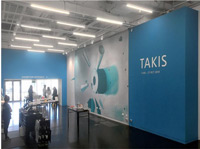
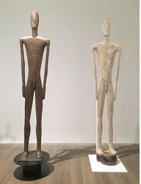
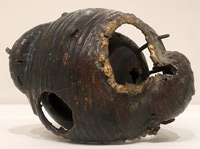
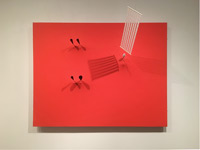
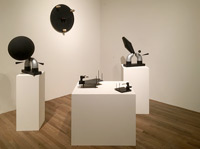
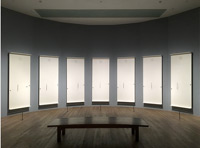
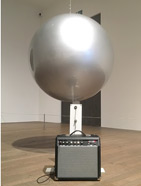
|
Takis’ Signals are his most renowned trademark from the mid 1950s. They are an ongoing series of tall rods springing from a base on the ground and tapering towards a finial at the top. Generally speaking, these finials are of particular symbolic significance and consist of either sculptures or found objects. The sculptures are various elements, whose form and shape evoke primordial symbols. In response to their interpretation, Takis said, “I am responsible only for manufacturing the symbols. Their meaning depends for interpretation on each and every one of us.” (in conversation with the author in 2004). With regard to the found objects in particular, they are either machine parts (i.e. batteries, carburators, radiators, ventilators) or parts of wartime equipment (i.e. bombs, guns, bayonets) that the artist transforms according to his needs. Speaking about such objects, “Takis cannot identify the hardware nor does he seek to, for the pieces were merely required to serve as anchors appropriate to the composition” (Calas 1984: 36). Takis’ Signals are wonderfully ambiguous; somewhere between the organic that is reminiscent of botanical stems, and the artificial that evokes standards used at war. In actual fact, his Signals are either discarded street and railroad signs from municipal depots or antennae from cast-off wartime vehicles. As Héléna and Nicolas Calas observe, Takis found an alternative to the utilitarian use of safety signals (Ibid 1984: 182). According to his experience in Calais early in the 1960s, “The station was a huge feral centre, a forest of signals. Monster-eyes went on and off, rails, tunnels, a jungle of iron... I drew all those phenomena... man constructs for his own use tunnels and exits, symbols for his evasion of death... For a long time now my Signals had been transformed into rockets, antennae and radio receivers.” (Ibid 1984: 182). Some years later, “A frequent traveller by plane, I was always enchanted by aerodromes and their great radars... It is as if they were monster instruments recording cosmic events... My last Signals took the form of electric antennae, like lightning conductors. But they still remained symbolical, they constituted a modern hieroglyphic language which had to be translated to be understood. The radar was a great active signal...” (Ibid 1984: 182). Takis’ Light Signals began to appear in 1966. The rod, which is familiar from other Signals, capitulates in various elements; either disks or panels with light-bulbs. Héléna and Nicolas Calas observe that the light bulb, though seemingly an extraneous feature, serves as the focal point on the composition (Ibid 1984: 36). Contemplating on his entire production of Signals, there is a forest of them, differing from one another in terms of height and form, and they all vary on the theme of energy emission and code transmission. The unique character of each Signal is fundamentally due to its randomness in timing and/or orientation. This feature makes every signal stand on its own, independently of humanity. They function on an emotive plane rather than on an instrumental level, as they ultimate aim is to salvage the cosmos.
Takis’ first Magnetic Wall appeared in 1961. All works in the series are complex and have felicitous grace. A bright coloured canvas screens magnets, which at minute distance from its surface hold five objects in suspension, each attached by a separate transparent wire to the ceiling. Although concealed, the magnets obtrude upon the canvas surface, forming irregular swellings which cast shadows, especially pronounced when the canvas is viewed from an angle. Takis insists that his Walls be also viewed in profile for only thus the complex interplay of colour-field, canvas surface, suspended objects, becomes manifest (Ibid 1984: 152). Structurally, these works can be viewed in terms of colour-field art, serving as target for magnetic energy with its component parts – magnets, magnetised objects and their tethers.
Takis has a long obsession with sound, and achieved a mastery over electromagnetic music. For him music is a sacred artistic expression. In particular, he recounts how Erik Satie’s Gymnopédies left an indelible impression on him. In his art Takis uses sound as a revelatory experience. “If only with an instrument like a radar I could capture the music of the beyond. This thought made me forget all the laws of art. If this object could capture and transmit sounds as it turned, my imagination would be crowned.” (Ibid 1984: 210). Takis had these thoughts in 1959, when he perceived of radar as a ‘magic instrument’, and materialised his thought in 1965 with the emergence of his Télésculpture Musicales. His idea was to string needles on stretched musical wire, as the needles target on magnets. Later he was to add a music-box and sound-amplifiers. He felt he was capturing “the music of the beyond”. On the occasion of Takis’ 1974 exhibition at the Espace Pierre Cardin, Paris, Pierre Restany writes, “Takis’ instruments generate chthonic sounds that challenge Prometheus to speak out with a poetic diction forged in agony and rebellion.” (Ibid 1984: 214). For his Télésculpture Musicales on exhibition at the Festival d’Automne in Paris, Restany observed, “Beyond the apparent verbosity of visual and sonorous discourse, beyond the cacophony and the disorder, once the first shock is overcome, one reaches a second perceptive state, a kind of ecstasy akin to serenity.” (Takis: Musicales 1974: 10).
Takis created his first Gong in 1974. It was small and - to his dismay - melodious. Over time he experimented with the materials and the dimensions until he finally reverted to steel sheets of monumental size. Héléna and Nicolas Calas wrote, “Takis’ Gongs re-awaken the spirit of antithesis, of a conflict between demoniac interruptions and heavenly percussions.” (Calas 1984: 236). In 1995, he represented Greece in the Venice Biennial, with a Gong reaching to a height of nine metres, made of a single steel sheet wedged tightly between ceiling and floor to create the necessary tension and produce the desired clang when the hammer, suspended in front of it, strikes the curved sheet. He described this Gong’s mysterious music as a ‘Pythagorean sound’ (in conversation with the author in 2004). |

